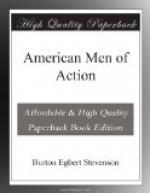So ended the greatest naval battle since Trafalgar—a battle which riveted the attention of the world, and brought home to Europe a realization of the fact that here was a new world-power to be reckoned with. With six ships, carrying 1,668 men and fifty-three guns, Dewey had destroyed the Spanish squadron of nine ships, carrying 1,875 men and forty-two guns; not an American had been killed, and only six wounded, while the Spanish loss was 618 killed and wounded; and not an American vessel had been injured. And, in addition to destroying the Spanish fleet, a series of powerful shore batteries had been silenced, and the way prepared for the American occupation of the Philippines. Dewey’s place as one of the great commanders of history was secure.
News of the victory created the wildest excitement and enthusiasm in the United States. Dewey became a popular hero, and when he returned from the Philippines, was welcomed with triumphal honors, which recalled the great days of the Roman empire. He was commissioned admiral of the navy, a rank which had been created for Farragut, and which has been held by only two men besides him.
Another great American naval victory marked the brief war with Spain—the destruction of Admiral Cervera’s powerful fleet as it tried to escape from the harbor of Santiago, Cuba, on the third day of July, 1898—a victory which made the Independence Day which followed one long to be remembered in the United States. There, as at Manila, the entire Spanish fleet was destroyed, without a single American vessel being seriously injured, and with a loss of only one killed and one wounded on the American side. But the victory at Santiago was the victory of no one man. The ranking officer, William Thomas Sampson, was miles away when the engagement began. The next in rank, Winfield Scott Schley, so conducted himself that he was brought before a court of inquiry. The battle was really fought and won by the commanders of the various ships—Robley D. Evans, John W. Philip, Charles E. Clark, Henry C. Taylor, Richard Wainwright—by the very simple procedure of getting as close to the enemy as they could, and hammering him as hard as their guns would let them. One and all, they behaved with the utmost gallantry. But most remarkable of all in the history of the navy from first to last has been the superb work of the “men behind the guns,” whose marksmanship has been the despair and envy of the world.
SUMMARY
JONES, JOHN PAUL. Born at Kirkbean, Kirkcudbrightshire, Scotland, July 6, 1747; settled in Virginia, 1773; appointed first lieutenant in American navy, 1775; commanded Ranger and cruised in the Irish sea, 1777-78; sailed from France in Bon Homme Richard, August 14, 1779; fought Serapis, September 23, 1779; resigned from American service, entered the French and later the Russian navy, served under Potemkin in the Black Sea with rank of rear-admiral; returned to Paris, 1790; died there, July 18, 1792.




